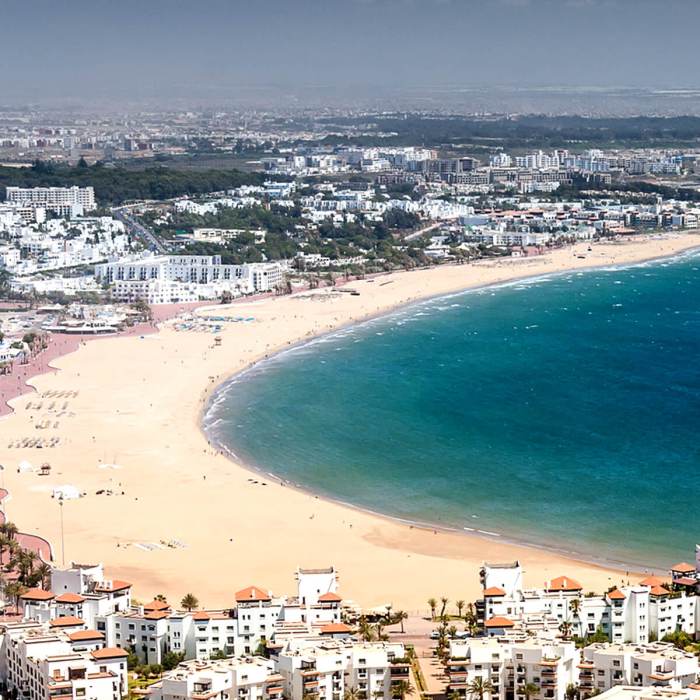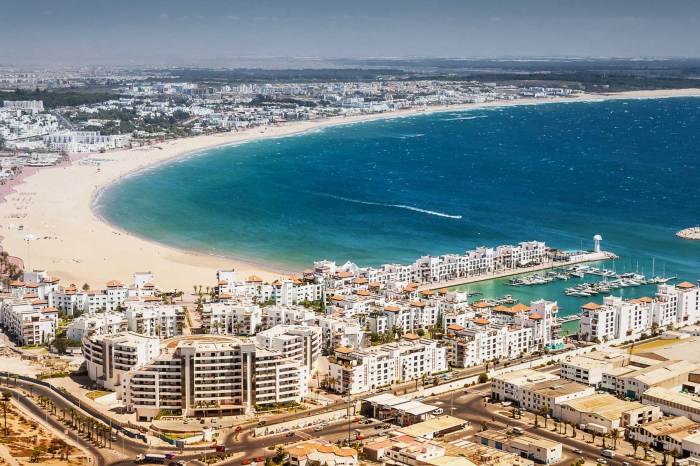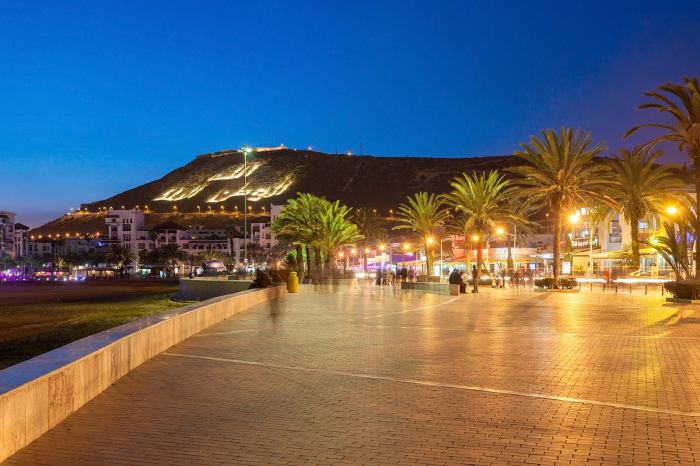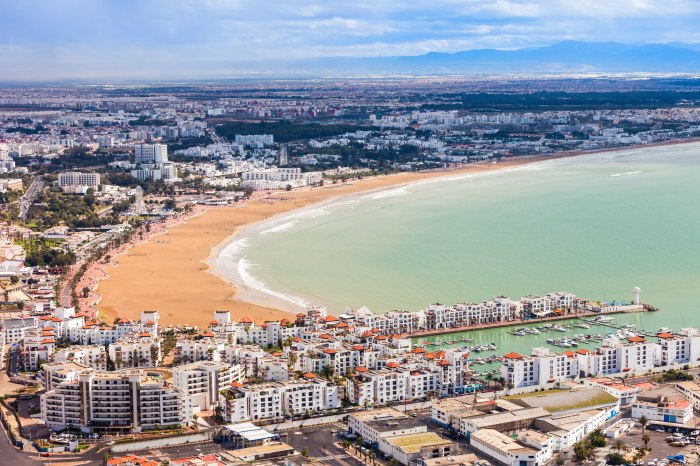Agadir, a captivating city nestled on Morocco’s Atlantic coast, invites you to a world of vibrant culture, breathtaking landscapes, and warm hospitality. From its golden beaches and majestic mountains to its rich history and modern infrastructure, Agadir offers a unique blend of tradition and modernity that will leave an unforgettable mark on your soul.
Agadir’s journey through time has been marked by Berber, Phoenician, and Portuguese influences, shaping its cultural tapestry. Today, it is a thriving metropolis, where the ancient Kasbah stands tall as a testament to the past, while modern skyscrapers grace the skyline, reflecting the city’s progressive spirit.
Geography of Agadir

Agadir is a coastal city located in southwestern Morocco, on the Atlantic Ocean. It is the capital of the Souss-Massa region and the ninth largest city in Morocco. Agadir is situated on a plain at the foot of the Anti-Atlas Mountains, with the Atlantic Ocean to the west and the Souss River to the south.
The climate of Agadir is subtropical, with mild winters and warm, sunny summers. The average temperature in January is 15°C (59°F), while the average temperature in July is 28°C (82°F). Agadir receives an average of 300 days of sunshine per year.
The terrain of Agadir is mostly flat, with some rolling hills. The Anti-Atlas Mountains rise to the east of the city, and the Souss River flows through the city center. Agadir is home to a number of beaches, including the popular Plage d’Agadir and the Plage de Taghazout.
The natural resources of Agadir include fish, phosphate, and minerals. The city is also a major tourist destination, with its beautiful beaches, golf courses, and casinos.
Comparison of Agadir’s Geographical Features to Other Major Cities in Morocco
| City | Location | Climate | Terrain | Natural Resources |
|---|---|---|---|---|
| Agadir | Southwestern Morocco, on the Atlantic Ocean | Subtropical, with mild winters and warm, sunny summers | Mostly flat, with some rolling hills | Fish, phosphate, minerals |
| Casablanca | Central Morocco, on the Atlantic Ocean | Mediterranean, with mild winters and hot, dry summers | Flat, with some low hills | Fish, minerals |
| Marrakech | Central Morocco, in the foothills of the Atlas Mountains | Continental, with hot, dry summers and cool, wet winters | Flat, with some rolling hills | Minerals, tourism |
| Rabat | Northern Morocco, on the Atlantic Ocean | Mediterranean, with mild winters and hot, dry summers | Flat, with some low hills | Fish, minerals |
| Tangier | Northern Morocco, on the Strait of Gibraltar | Mediterranean, with mild winters and hot, dry summers | Flat, with some low hills | Fish, minerals |
History of Agadir

Agadir, a vibrant coastal city in southern Morocco, boasts a rich and multifaceted history spanning centuries. From its humble origins as a Berber fishing village to its present-day status as a bustling tourist hub, Agadir’s story is interwoven with the ebb and flow of civilizations, trade, and cultural influences.
Archaeological evidence suggests that the area around Agadir has been inhabited since prehistoric times. However, it was not until the 15th century that the city began to take shape under the rule of the Saadian dynasty. The Saadians established Agadir as a major port and trading center, connecting Morocco to the wider world through maritime trade routes.
Portuguese Influence
In 1505, the Portuguese arrived in Agadir and established a trading post. They fortified the city and named it Santa Cruz do Cabo de Gué. The Portuguese presence in Agadir lasted for nearly a century, during which time they introduced European architectural styles and technologies to the city. The Portuguese also played a significant role in developing Agadir’s fishing industry.
Saadian Rule
In 1541, the Saadians reconquered Agadir from the Portuguese. Under their rule, the city continued to flourish as a commercial and cultural center. The Saadians constructed several important buildings in Agadir, including the Kasbah, which served as the city’s citadel and administrative center.
Alaouite Dynasty
In the 17th century, the Alaouite dynasty came to power in Morocco. Under the Alaouites, Agadir’s importance as a port declined somewhat, as the capital was moved to Fez and later to Marrakech. However, the city remained an important trading center and a gateway to the Sahara.
French Protectorate, Agadir
In 1912, Morocco became a French protectorate. The French invested heavily in Agadir’s infrastructure, including the construction of a new port and a railway line connecting the city to Marrakech. During the French protectorate, Agadir also became a popular tourist destination.
Independence
Morocco gained independence from France in 1956. Agadir continued to grow and develop in the post-independence era. In 1960, the city was devastated by a massive earthquake that killed thousands of people. However, Agadir was quickly rebuilt and has since become one of the most popular tourist destinations in Morocco.
Timeline Infographic
Here is a timeline infographic illustrating the key historical milestones of Agadir:
- Prehistoric times: The area around Agadir is inhabited by Berber tribes.
- 15th century: The Saadians establish Agadir as a major port and trading center.
- 1505: The Portuguese arrive in Agadir and establish a trading post.
- 1541: The Saadians reconquer Agadir from the Portuguese.
- 17th century: The Alaouites come to power in Morocco.
- 1912: Morocco becomes a French protectorate.
- 1956: Morocco gains independence from France.
- 1960: Agadir is devastated by a massive earthquake.
- Present day: Agadir is a thriving tourist destination and a major economic center in southern Morocco.
Culture and People of Agadir
Agadir, a vibrant coastal city in Morocco, is a melting pot of diverse cultures and traditions. Its inhabitants, known for their warm hospitality and rich heritage, have preserved unique customs and beliefs that define the city’s identity.
Local Cuisine
Agadir’s cuisine is a culinary tapestry that reflects the city’s multicultural influences. Seafood takes center stage, with fresh catches from the Atlantic Ocean featuring prominently in local dishes. The aromatic blend of spices, including cumin, saffron, and paprika, adds a tantalizing depth of flavor to every meal. Traditional dishes include tagine, a slow-cooked stew of meat and vegetables, and couscous, a semolina-based dish often served with flavorful sauces and toppings.
Music and Art
Music is an integral part of Agadir’s cultural fabric. The rhythmic beats of Gnaoua music, with its origins in sub-Saharan Africa, fill the streets during festivals and celebrations. Traditional Berber music, with its haunting melodies and poetic lyrics, is also popular. Agadir’s art scene is equally vibrant, with local artisans showcasing their skills in intricate pottery, colorful textiles, and handcrafted jewelry.
Festivals
Throughout the year, Agadir hosts a variety of festivals that celebrate the city’s culture and heritage. The Timitar Festival, held annually in July, brings together renowned Moroccan and international musicians for a week-long extravaganza of music and dance. The Festival of the Almond Tree, held in February, celebrates the region’s almond harvest with traditional music, dance, and local delicacies.
Ethnic Groups and Languages
Agadir is home to a diverse population, with the majority being ethnic Arabs and Berbers. The city also has a significant population of sub-Saharan Africans and Europeans. Arabic is the official language, while Berber dialects are widely spoken in rural areas. French and Spanish are also spoken by many locals, reflecting the city’s colonial history.
Economy of Agadir

Agadir’s economy is primarily driven by tourism, fishing, and agriculture. The city is a popular tourist destination due to its beautiful beaches, mild climate, and rich cultural heritage. Tourism contributes significantly to the city’s economy, providing employment opportunities in hotels, restaurants, and other tourism-related businesses.
Fishing is another important industry in Agadir. The city is home to a large fishing port, and the fishing industry provides employment for many local residents. Agadir is also a major center for the export of fish and seafood products.
Agriculture is another important economic activity in the Agadir region. The region is known for its production of citrus fruits, vegetables, and olives. Agriculture provides employment for many local residents and contributes to the city’s economy.
The following table compares Agadir’s economic indicators to the national average of Morocco:
| Indicator | Agadir | Morocco |
|—|—|—|
| GDP per capita | $4,500 | $2,500 |
| Unemployment rate | 10% | 15% |
| Poverty rate | 15% | 25% |
As the table shows, Agadir’s economy is performing better than the national average of Morocco. The city has a higher GDP per capita, a lower unemployment rate, and a lower poverty rate. This is due in part to the city’s strong tourism industry and its role as a major fishing and agricultural center.
Tourism in Agadir

Agadir’s tourism industry has flourished over the years, solidifying its status as a sought-after destination for travelers worldwide. The city boasts an array of attractions, from pristine beaches and stunning natural landscapes to historical sites and cultural landmarks.
Agadir’s infrastructure caters to the needs of tourists, with modern hotels, restaurants, and transportation systems ensuring a comfortable and convenient stay. The city has also made significant investments in developing its tourism sector, such as the construction of a new marina and the expansion of its airport.
Target Markets
Agadir’s tourism industry targets a diverse range of markets, including:
- Beachgoers: Agadir’s stunning beaches are a major draw for sun-seekers and water sports enthusiasts.
- Golfers: Agadir is home to several world-class golf courses, attracting golfers from around the world.
- Culture enthusiasts: The city’s historical sites, museums, and cultural events appeal to those interested in exploring Moroccan heritage.
- Adventure seekers: Agadir offers opportunities for hiking, surfing, and other outdoor activities, catering to adventure-minded travelers.
Impact on the Local Economy and Culture
Tourism has had a significant impact on Agadir’s economy and culture. The industry has created numerous jobs in the hospitality, transportation, and retail sectors, contributing to the city’s overall economic growth. Additionally, tourism has helped promote Agadir’s cultural heritage and traditions, fostering a sense of pride among locals and attracting visitors eager to experience authentic Moroccan culture.
Agadir, with its golden beaches and vibrant atmosphere, offers a captivating coastal escape. Its charm extends beyond the shores, as its proximity to Annecy, France invites travelers to explore a picturesque alpine town renowned for its crystal-clear lake and medieval architecture.
While Annecy offers a tranquil retreat, Agadir welcomes visitors back to its lively streets and breathtaking sunsets, ensuring a memorable and diverse travel experience.
Promotional Brochure: Agadir’s Top Tourist Destinations
Front Page:
Discover Agadir, Morocco’s Sun-Kissed Gem
Explore a captivating blend of beaches, culture, and adventure in Agadir, a vibrant city on the Atlantic coast of Morocco. From its stunning beaches to its rich history and vibrant nightlife, Agadir offers an unforgettable experience for every traveler.
Inside Pages:
Beaches:
- Agadir Beach: A long stretch of golden sand, perfect for sunbathing, swimming, and water sports.
- Taghazout Beach: A popular surfing spot with consistent waves and a laid-back atmosphere.
- Tamraght Beach: A picturesque beach with stunning views of the Atlantic Ocean.
Golf Courses:
- Golf du Soleil: An 18-hole championship course with stunning views of the ocean and mountains.
- Agadir Golf Course: A challenging 9-hole course located in the heart of the city.
- Tazegzout Golf Course: A scenic 18-hole course set amidst rolling hills and lush vegetation.
Cultural Sites:
- Kasbah of Agadir: A 16th-century fortress offering panoramic views of the city and ocean.
- Agadir Oufella: The ruins of an ancient Portuguese settlement, located on a hilltop overlooking the city.
- Souk El Had: A bustling market where visitors can experience the vibrant atmosphere of traditional Moroccan trade.
Back Page:
Plan your unforgettable getaway to Agadir today and immerse yourself in the vibrant culture, stunning beaches, and endless adventures that await you.
Agadir, Morocco, boasts stunning beaches, lush golf courses, and a vibrant nightlife scene, making it a top luxury travel destination. For those seeking an unforgettable travel experience, consider exploring other top luxury travel destinations that offer a blend of relaxation, adventure, and cultural immersion.
Upon your return, Agadir will welcome you back with its warm hospitality and endless opportunities for indulgence.
Infrastructure and Development of Agadir
Agadir boasts a well-developed infrastructure that supports its thriving economy and growing population. The city has a modern transportation network, reliable utilities, and a comprehensive healthcare system.
Transportation
Agadir is well-connected by air, land, and sea. Al Massira Airport (AGA) serves the city with domestic and international flights. The city is also a major hub for bus and train transportation, with regular services to major cities in Morocco and beyond. Agadir’s port, one of the largest in the country, handles both passenger and cargo traffic.
Utilities
Agadir has a reliable supply of electricity, water, and gas. The city’s power grid is modern and efficient, ensuring a stable supply of electricity to homes and businesses. The water supply is also reliable, with a network of pipelines and reservoirs that provide clean water to the entire city. Natural gas is also widely available in Agadir, providing a clean and efficient source of energy for heating and cooking.
Healthcare
Agadir has a comprehensive healthcare system that provides a wide range of medical services to its residents. The city is home to several hospitals, clinics, and medical centers, including the Agadir Regional Hospital, one of the largest and most modern hospitals in Morocco. The healthcare system in Agadir is well-staffed and provides a high level of care to patients.
Ongoing Development Projects
Agadir is undergoing a number of major development projects that are expected to further enhance the city’s infrastructure and boost its economy. These projects include:
– The construction of a new high-speed rail line that will connect Agadir to Casablanca and other major cities in Morocco.
– The expansion of Al Massira Airport to accommodate more flights and passengers.
– The development of a new port terminal that will increase the city’s capacity for cargo and passenger traffic.
– The construction of new hospitals and clinics to meet the growing demand for healthcare services.
These development projects are expected to have a significant impact on Agadir, making it a more attractive destination for businesses and tourists alike.
Key Infrastructure Projects and Their Expected Impact
| Project | Expected Impact |
|—|—|
| High-speed rail line | Reduced travel times to major cities, increased tourism, and economic development |
| Airport expansion | Increased tourism, improved connectivity, and economic growth |
| New port terminal | Increased cargo and passenger traffic, economic development |
| New hospitals and clinics | Improved healthcare services, increased population growth, and economic development |
Challenges and Opportunities for Agadir
Agadir, like many rapidly developing cities, faces a number of challenges that hinder its sustainable growth and prosperity. These challenges include environmental issues, social inequality, and a lack of economic diversification. However, the city also has a number of opportunities to address these challenges and promote sustainable growth. These opportunities include developing renewable energy sources, investing in education and healthcare, and promoting tourism and trade.
Environmental Challenges
One of the biggest challenges facing Agadir is environmental degradation. The city’s rapid growth has led to increased air and water pollution, as well as deforestation. These environmental problems have a negative impact on the health of the city’s residents and on the local economy.
Social Challenges
Agadir also faces a number of social challenges, including poverty, unemployment, and crime. These challenges are often concentrated in the city’s informal settlements, where residents lack access to basic services such as housing, water, and sanitation. The lack of social mobility and economic opportunities can lead to social unrest and instability.
Agadir, a popular coastal city in Morocco, offers a diverse range of activities for travelers. While sunbathing and swimming are popular pastimes, adventure seekers can explore the underwater world through scuba diving. Agadir’s proximity to the Atlantic Ocean provides access to numerous scuba diving locations , where divers can encounter a variety of marine life, including colorful fish, sea turtles, and even shipwrecks.
After a thrilling day of exploration, visitors can relax on the sandy beaches of Agadir, enjoying the warm Moroccan sunshine.
Economic Challenges
Agadir’s economy is heavily dependent on tourism. This makes the city vulnerable to economic downturns and fluctuations in the tourism industry. The city also lacks a diversified economy, which makes it difficult to create new jobs and attract investment.
Opportunities for Sustainable Growth
Despite the challenges it faces, Agadir has a number of opportunities to promote sustainable growth. These opportunities include:
- Developing renewable energy sources: Agadir has a lot of potential for solar and wind energy. Developing these renewable energy sources could help the city to reduce its dependence on fossil fuels and improve its environmental sustainability.
- Investing in education and healthcare: Investing in education and healthcare can help to improve the lives of Agadir’s residents and make the city more attractive to businesses and investors.
- Promoting tourism and trade: Agadir has a lot to offer tourists, including beautiful beaches, a rich history, and a vibrant culture. Promoting tourism and trade can help to create jobs and boost the city’s economy.
Recommendations for Improving Agadir’s Overall Development
Based on the challenges and opportunities discussed above, the following recommendations are made for improving Agadir’s overall development:
- Invest in renewable energy sources to reduce the city’s dependence on fossil fuels and improve environmental sustainability.
- Invest in education and healthcare to improve the lives of Agadir’s residents and make the city more attractive to businesses and investors.
- Promote tourism and trade to create jobs and boost the city’s economy.
- Develop a more diversified economy to make the city less vulnerable to economic downturns and fluctuations in the tourism industry.
- Address the challenges of poverty, unemployment, and crime, particularly in the city’s informal settlements.
- Improve the city’s infrastructure and public services to make it more livable and attractive to residents and businesses.
Final Conclusion
Agadir’s allure extends beyond its physical beauty. It is a city where the warmth of the people matches the sunshine, and the rhythm of life flows in harmony with the ebb and flow of the tides. Whether you seek adventure, relaxation, or a glimpse into Morocco’s rich heritage, Agadir promises an experience that will linger in your heart long after you bid farewell to its shores.
FAQ Summary
What is the best time to visit Agadir?
Agadir enjoys year-round sunshine, but the best time to visit is during the shoulder seasons (April-May and September-October) when the weather is mild and pleasant.
What are the must-see attractions in Agadir?
Don’t miss the Kasbah, a 16th-century fortress with panoramic city views; the Souk El Had, one of Morocco’s largest open-air markets; and the Agadir Beach Promenade, a lively stretch of coastline with cafes, restaurants, and shops.
Is Agadir a safe city for tourists?
Yes, Agadir is generally considered a safe city for tourists. However, as with any travel destination, it’s always advisable to take precautions and be aware of your surroundings.